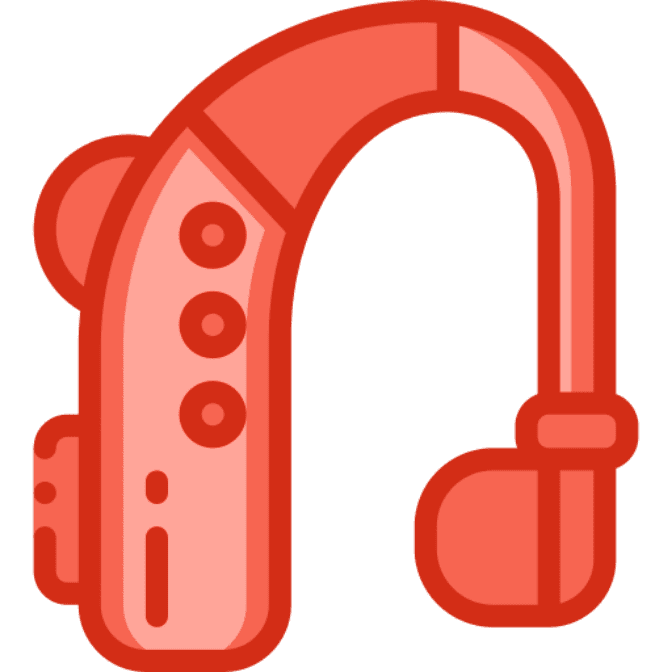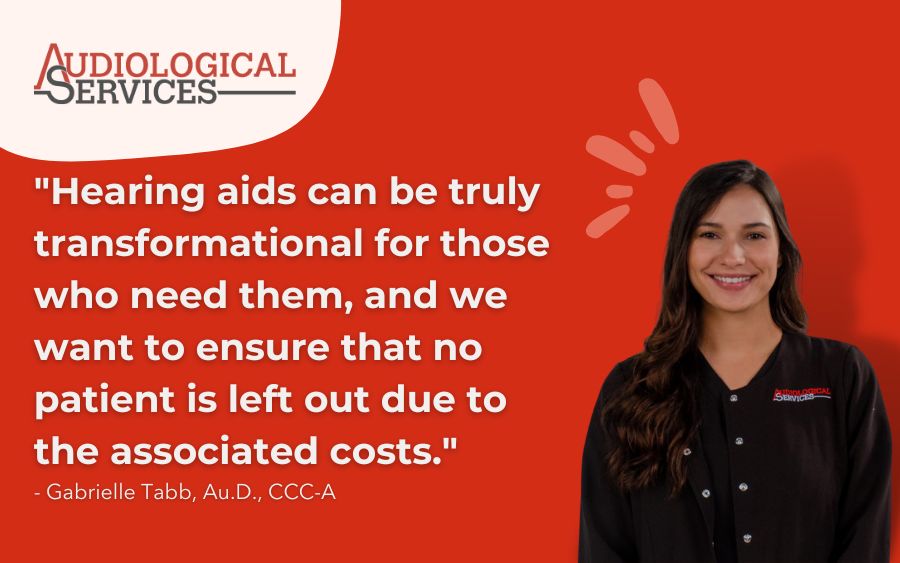Assistive Hearing Technology in Lufkin, TX
Hearing aids provide the best solution to help those with a hearing loss to continue to enjoy their daily life, but there are situations and circumstances when hearing aids just aren’t enough.
Even if you use hearing aids, you might need something more to enjoy a better hearing experience and richer quality of life. In addition to fitting you with hearing aids and providing ongoing support, Audiological Services provides assistive hearing technology to fill in some of the gaps in your ability to communicate in public and private settings.
Assistive hearing technology consists of two different types of technology: assistive listening devices (ALD) for a personal connection to audio sources and assistive listening systems (ALS) to help individuals with hearing challenges to hear better in public places like theaters and lecture halls.

ALD Hearing Devices
There are numerous ALDs available today, from sophisticated systems used in theaters and auditoriums to small personal systems used by the individual in his or her daily life. ALDs allow a person to hear others speak and participate in conversations.

Personal Listening Systems
There are several types of personal listening systems available. All are designed to carry sound from the speaker (or other source) directly to the listener and to minimize or eliminate environmental noises. Some of these systems, such as auditory trainers, are designed for classroom or small group use.
Personal frequency modulated (FM) systems and personal amplifiers are especially helpful for one-to-one conversations in places such as automobiles, meeting rooms, and restaurants.

TV Listening Systems
TV listening systems are designed for hearing the TV, radio, or stereo without interference from surrounding noise or the need to use excessively high volume.
Models of TV listening systems are available for use with or without hearing aids. These systems allow the family to set the volume of the TV while the user adjusts only the volume of his or her own hearing requirements.

Direct Audio Input Hearing Aids
Direct audio input hearing aids are hearing devices with direct audio input connections, which are usually wires.
These wires can be connected to the TV, stereo, and radio, as well as to microphones, auditory trainers, personal FM systems, and other assistive devices.

Telephone Amplifying Devices
Most, but not all, standard telephone receivers can be used with hearing aids. These phones are called “hearing aid compatible.” The option on the hearing aid to be utilized with landline phones is called the T-Coil. The T-Coil is automatically activated on some hearing aids and manually activated on others. Basically, the telephone and the hearing aid’s T-Coil communicate with each other electromagnetically, allowing the hearing aid to be used at a comfortable volume without feedback and with minimal background noise.
You should be able to get a hearing-aid-compatible telephone amplifying device from your phone company or almost any retail store that sells telephones. Not all hearing aids have “T” switch technology. Make sure your hearing aids have a T-Coil switch before purchasing a new hearing-aid-compatible phone! There are dozens of T-Coil and telephone coupling systems. Speak with your hearing healthcare provider to get the most appropriate system for your needs.

Cell Phones
Modern hearing aids can be used with most cell phones. Importantly, digital hearing aids and digital phones may create constant noise or distortion.
There may be significant problems for some hearing aids when used with particular cell phones. Regarding “hands free” cell phone systems, there are many from which to choose, and users with a hearing loss usually benefit maximally by using binaural hands-free systems.

Personal Listening System
There are several types of personal listening systems available. All are designed to carry sound from the speaker (or other source) directly to the listener and to minimize or eliminate environmental noises. Some of these systems, such as auditory trainers, are designed for classroom or small group use.
Personal frequency modulated (FM) systems and personal amplifiers are especially helpful for one-to-one conversations in places, such as automobiles, meeting rooms, and restaurants.

TV Listening Systems
TV listening systems are designed for hearing the TV, radio, or stereo without interference from surrounding noise or the need to use excessively high volume.
Models of TV listening systems are available for use with or without hearing aids. These systems allow the family to set the volume of the TV while the user adjusts only the volume of his or her own hearing requirements.

Direct Audio Input Hearing Aids
Direct audio input hearing aids are hearing devices with direct audio input connections, which are usually wires.
These wires can be connected to the TV, stereo, and radio, as well as to microphones, auditory trainers, personal FM systems, and other assistive devices.
Telephone Amplifying Devices
Most, but not all, standard telephone receivers can be used with hearing aids. These phones are called “hearing aid compatible.” The option on the hearing aid to be utilized with landline phones is called the T-Coil. The T-Coil is automatically activated on some hearing aids and manually activated on others. Basically, the telephone and the hearing aid’s T-Coil communicate with each other electromagnetically, allowing the hearing aid to be used at a comfortable volume without feedback and with minimal background noise.
You should be able to get a hearing-aid-compatible telephone amplifying device from your phone company or almost any retail store that sells telephones. Not all hearing aids have “T” switch technology. Make sure your hearing aids have a T-Coil switch before purchasing a new hearing-aid-compatible phone! There are dozens of T-Coil and telephone coupling systems. Speak with your Hearing Health Care Provider to get the most appropriate system for your needs.

Cell Phones
Modern hearing aids can be used with most cell phones. Importantly, digital hearing aids and digital phones may create constant noise or distortion.
There may be significant problems for some hearing aids when used with particular cell phones. Regarding “hands free” cell phone systems, there are many from which to choose, and hearing-impaired users usually benefit maximally by using binaural hands-free systems.
Assistive Listening Systems for Public Settings
Assistive listening systems (ALSs) are used in theaters, airports, churches, lecture halls, and other public places. They are mandated and regulated by the Americans with Disabilities Act (ADA) and public facilities must post notification of the system at entrances to buildings with ALS.
There are three approved types of assistive listening systems:
Hearing Loops (aka induction loops or audio frequency induction loop systems), which are connected via a loop driver in a public address system and include a system of copper wire placed within a room, theater, or counter. Wireless sound transmission is accomplished via small changes in the magnetic field and is directed into the telecoil of hearing aids, cochlear implants, or telecoil receivers worn on the body.
Radio Frequency (FM or DM ALS) systems transmit wireless, low-power FM frequency radio transmission from a sound system to FM receivers. The system requires a receiver and either headphones or a neckloop, but those with telecoil-equipped hearing aids or neckloops can receive the signals without additional equipment.
Infrared Systems (IR) use speech or sound transmission from a public address system to transmit invisible infrared light waves to an IR receiver. This technology requires line-of-sight and is interrupted in direct sunlight.
How Do I Know if I Need the Help of ALD or ALS?

You may be an ideal candidate for an ALD if you relate to some or any of the following statements:
- I often have to strain to hear conversations.
- I am frustrated after struggling to carry on a conversation.
- I have to turn the television and radio up to maximum volume.
- I often accuse loved ones and friends of mumbling.
- I struggle to hear strangers who speak to me.
- I often have to ask people to repeat themselves because I don’t understand what they say.
- People accuse me of speaking loudly when I talk.
- I can hear better out of one ear than the other one.
- When someone is talking, it sounds like their words are jumbled together.
The age of those who benefit from ALD and ALS systems can range from young children to older adults as well as individuals with disabilities. If your hearing is significantly impaired, an ALD may be just the type of assistance you need to communicate with the people around you.
CaptionCall Can Help You Reclaim Your Phone and Your Life

CaptionCall® is a revolutionary new telephone and service for anyone who has trouble hearing on the phone. While hearing loss affects millions of people for many different reasons — age, illness, injury, loud working conditions, and military service among them — it doesn’t have to limit the quality of their phone conversations. With CaptionCall, it’s easy to communicate confidently with friends, family, and colleagues.
Similar to captioned television, CaptionCall uses advanced technology and a communications assistant to quickly provide written captions of what callers say on a large, easy-to-read screen. It works like a regular telephone – simply dial and answer calls as usual and speak and listen using a phone handset like always. Plus, CaptionCall offers exceptional sound quality with audio and frequency settings that can be customized to each person’s hearing loss.
Features of Our Captioned Telephone
This state-of-the-art, yet surprisingly simple, telephone empowers you to communicate more confidently with friends, family, or co-workers. With the CaptionCall phone, you’ll enjoy:
- Large text – 7″ screen with adjustable text sizes makes it easy to read every word of every call.
- Location flexibility – set up your phone by using a wired or wireless internet connection.
- Touch to call – make calls quickly and easily with a simple touch of the screen.
- Saved conversations – you can choose to save the captioning from conversations for later review.
- Customizable audio — easily adjust ringer and handset volume — also customize frequency amplification.
- Saved volume settings – volume settings can be customized and saved to provide the best experience on every call.
- Telecoil loop connection – for hearing aids with a telecoil option.
- Secure captioning – enjoy a safe, encrypted FCC-regulated transcription process.
- Mute Button – mute outgoing audio.
- Visual Ringer – the CaptionCall phone screen can flash when the phone is ringing.

CaptionCall® Mobile

CaptionCall Mobile enables people with a hearing loss to make and receive captioned telephone calls from their iPad so you understand every word of every call, everywhere. The CaptionCall Mobile application is FREE and available in the Apple App Store to download.
CaptionCall Mobile requires a CaptionCall account, an Apple® iPad® 2 or later, and a Wi-Fi or cellular Internet connection.
Qualify for a FREE CaptionCall Phone
To qualify for a FREE CaptionCall phone, contact our office to obtain certification that you have hearing loss and experience difficulty hearing on the phone.
To qualify, you must meet these three CaptionCall Requirements:
- A hearing loss that necessitates the use of captioned telephone service
- An internet connection and a standard home phone connection
- A Professional Certification Form certifying your hearing loss
Ask Us About Assistive Hearing Technology
Hearing aid technology is impressive and can be a big help for people with a hearing loss, but if you have unique needs that aren’t addressed by your hearing aids or you aren’t yet ready for hearing aids, an assistive listening device can provide a solution.
To learn more about the variety of assistive hearing technology available from Audiological Services, contact us by using the adjacent form and one of our hearing care specialists will call you back to address your questions or concerns.
"*" indicates required fields



